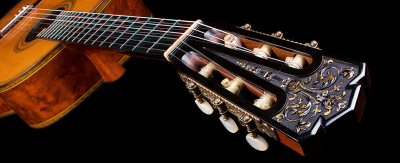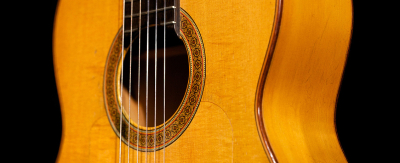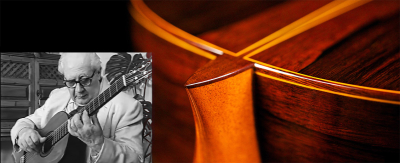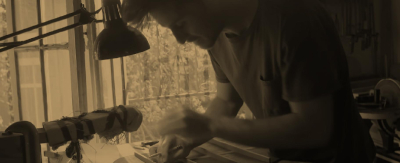New Videos & "A Week With GSI" Mateusz Kowalski's Social Media Project
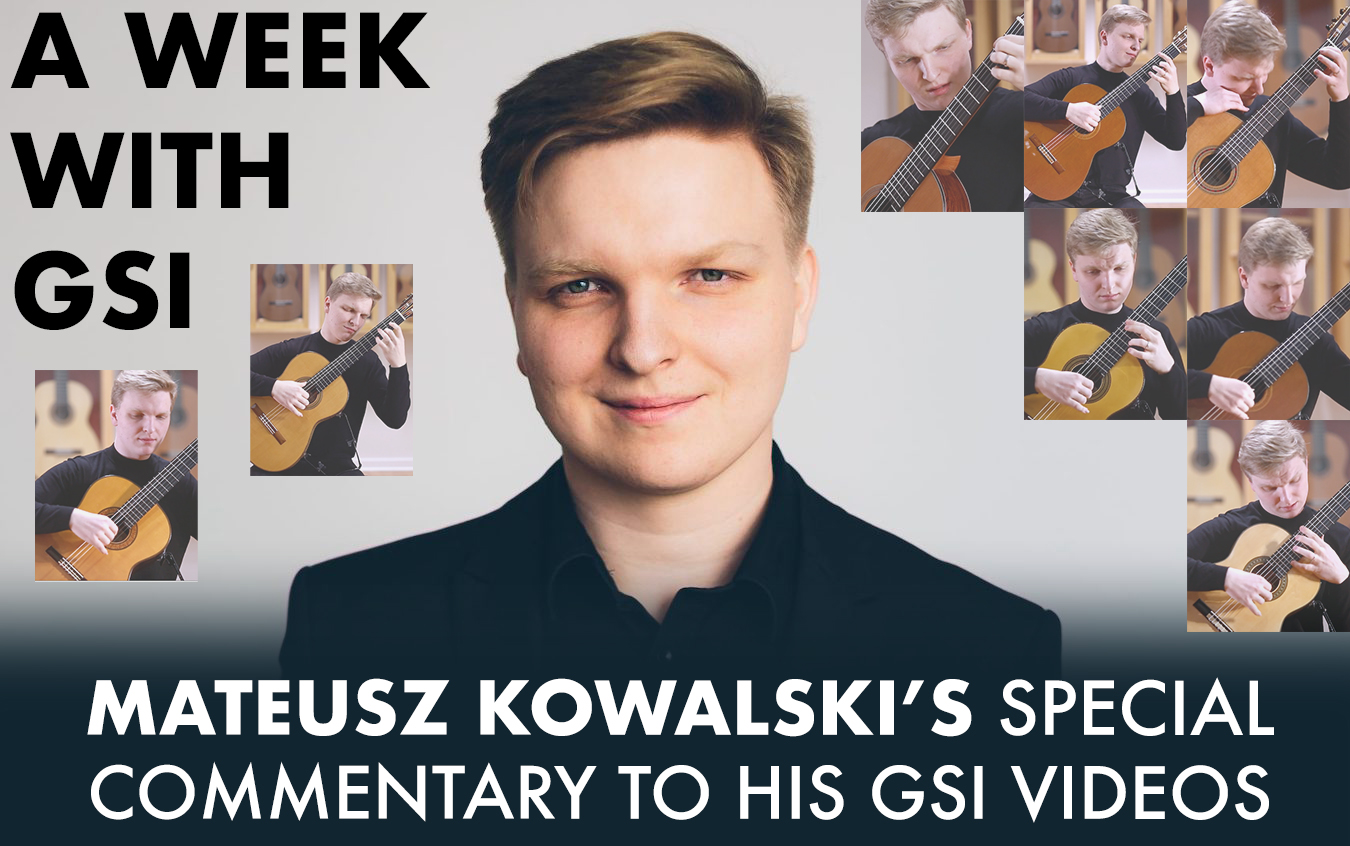
Mateusz Kowalski is a newly rising star in the classical guitar scene. His spectacular success from winning the EuroStrings guitar competition has brought him broad recognition around the world.
Mateusz became famous among our subscribers even before his GSI videos were officially published. The sneak peek video of his recording session in which he played a fragment of “Hora” by Štěpán Rak went viral and has reached almost 325,000 views on Facebook.
Right before the pandemic lockdown Mateusz visited our GSI showroom and recorded 8 videos on 7 different guitars! Mateusz performed Štěpán Rak’s “Hora” on a 2020 Cordoba Luthier Select Series “Friederich”; Giuliani’s “Rossiniana No. 1: Allegro Vivace” and Tárrega’s “Sueño – Mazurka in C” on a 1975 Rodriguez “Churchdoor”; Ástor Piazzolla’s “Invierno Porteño” on a 2019 Pavel Gavryushov and “Primavera Porteña” on a 1994 Thomas Humphrey “Millennium”; Franz Schubert’s “Moment Musicaux No. 3” on a 2012 Thomas Norwood “1932 Esteso”; Barrios’s Contemplación on a 2020 Luis Fernandez De Cordoba and Bach’s “Prelude from BWV 1006a” on a 2007 Fritz Ober.
Mateusz Kowalski has also reached out to us recently about his newest social media project called “A Week with GSI”. At the beginning of May, Mateusz is going to post social media articles about the pieces he performed in our showroom, as well as his personal feelings and thoughts regarding each instrument on which he recorded at GSI.
UPDATE: We’re almost near the end of Mateusz’s series of social media posts “A Week with GSI”. Check out Mateusz’s posts about each video below and stay tuned for the last two posts to be published very soon!
Each time I play this piece, I’m reminded of a story that my good friend Sebastian Boguszewski told me. On his travels to Romania he had the opportunity to explore local culture and experience the famous Balkan hospitality.
One time, he was invited with his friends by complete strangers to their house for a dinner-and-integration evening. After the meal, the hosts started dancing. They danced in a circle, moving in a difficult to repeat, irregular sequence of steps.
The dance was horo (oro) – one of the oldest Balkan folk dances. A remarkable Czech composer Stepan Rak was inspired to write this piece by Vladislav Bláha. The objective was to create a composition demanding in terms of technique, which would present in a short span of time the virtuosity and agility of both the right and the left had of the player. The beginning of the track is an excellent example of the fact that playing with just the left hand is absolutely possible. A perfect piece for an encore!
The guitar used in this recording was 2020 CORDOBA LUTHIER SELECT SERIES “FRIEDERICH.” This instrument, particularly comfortable for the left hand, inspired the use of various tones. Significant dynamic capabilities made it even easier and more intuitive.
In Francisco Tárrega, you don’t even have to look for or imagine associations and links between guitar and piano music. Apart from being an innovative composer, he was also a virtuoso concert guitarist touring Europe, and a talented pianist. He loved to transcribe piano pieces, including Beethoven, Schubert, Albéniz and Chopin, for six strings.
The Mazurka in C major dubbed “Sueño” is one of the mazurkas Tárrega wrote at the turn of the 20th century. Modelled after Chopin’s Mazurka in B major op. 7 no. 1, it is a piece filled with sunshine, combining a lively character with a note of nostalgia and reflection.
If someone were to ask me what longing sounds like, I’d say that it sounds like a minor melody from the middle section of this mazurka. The piece was recorded on the 1975 Miguel Rodriguez “Churchdoor” guitar. It’s one of the most wonderful instruments I’ve ever played. The ease with which you can draw a full, strong and vivid sound from a Rodriguez is astonishing. Cedar guitars often lack clarity provided by spruce. There was no such problem in this case. Buzzing and other undesirable sounds which can happen with an imprecise hold of left hand fingers on a string – you can forget all about them with a Churchdoor. It’s a universal instrument of extraordinary beauty.
My beloved / My soul loves you / And experiences sweet throbbing / That words cannot describe.
These are the lyrics of the opera duo of Armida and Rinaldo from Gioacchino Rossini’s opera Armida. It was the inspiration for Mauro Giuliani to write the finale of his Rossiniana op. 119 no. 1. A piece written for soprano and tenor is often performed alongside the preceding Amor..possente nome!, Vacila a quegli accenti, manca la mia costanza and Ah! Non poss’io resistere.
In the aria, Rinaldo is faced with a difficult choice: love or duty? He choses the feelings he has for the beautiful Armida.
The guitar is once again the phenomenal Miguel Rodriguez “Churchdoor” from 1975. It is rare that an instrument that loud still offers so many tones and timbres. With this one, the sound of guitar can indeed resemble a small orchestra.
Since the 1820s, Schubert’s musical moment remains one of the most popular pieces of music. It was transcribed multiple times, and a guitar version, with certain deviations from the original, was made by Francisco Tárrega. In the video you can hear my own arrangement, a bit more faithful to the piano original when it comes to the melodic line. Interestingly enough, my concert audiences respond to this work in many different ways. For many listeners it is a light, amusing miniature. But my feeling is that the incessant staccato rhythm foreshadows something ominous – like a clock ticking away before the inevitable comes. What are your impressions?
This time I used the Thomas Norwood “Esteso” guitar. It’s one of the most delicate instruments I have ever played. It has an exceptionally warm tone on treble strings, in wonderful proportion to the bass ones. This guitar brings to mind instruments from the 19th century, as it has all their advantages – a natural timbre and clarity of sound.
Winter and Spring from Astor Piazzolla’s “Estaciones Porteñas” cycle offer two separate insights into the world of Latin American music, this time through the lens of the Argentine tango. If it is true that bandoneon is the soul of the tango, than Assad must have pried it away somehow, and gave it to the guitar. And it’s highly unlikely he winds up in hell for it.
Winter is based on a single melody, featured repeatedly throughout the duration of the piece; each time in a different manner or a different key. For me, it’s the music of leaving, the melody of the end, and every iteration corresponds to a possible reaction to the end – the feelings of resignation, anger, and many others.
In this recording I used a 2019 Pavel Gavryushov guitar. The instrument provides a deep, full sound – perfect for pouring your heart out through music. It doesn’t mean that it can’t be playful or mischievous; if necessary, the guitar offers quick, energetic sound positively bursting out of the sound hole.
Spring from Astor Piazzolla’s Estaciones Porteñas cycle is not a typical spring that brings joy and hope. For me it’s a painful call for action – an appeal to continue an eternal struggle. What’s more, it reminds us that every beginning, by its nature, also implies an end.
The guitar is a 1994 Thomas Humphrey “Millennium”. It’s an instrument with a remarkably delightful sound and a surprisingly extended range of darker tones, balanced out by a crystal-clear sounding fourth string. The elevated fingerboard made playing in high positions significantly easier.
Paraguay-born Agustín Barrios Mangoré was for a long time one of the least popular figures in Latin American music, and we owe the return of his works to the performance practice to the publication of his sheet music in the 1970s and John Williams’ fascination with the newly discovered artist. Barrios is also considered to be the first classical guitarist to have made a gramophone record. His work as a composer included three main areas: stylised folk music, emulation and pastiche (mostly of European Baroque and Romanticism), and religious music. Contemplación is one of around 300 pieces he composed surviving today. The subtitle Vals et Tremolo refers both to the rhythmic structure of the lyrical dance, and the articulation figure continuously building and maintaining the narrative of this miniature poem.
For me, Contemplación helps bring back pleasant memories. It also facilitates entering the mindset for contemplating the passage of time, leaving the listener with hope, in a state of almost heavenly bliss.
The instrument used in the video is a 2020 Luis Fernandez de Cordoba. A very elegant guitar with a remarkably sweet, selective sound. There is no place for obliqueness, everything is loud and clear.
Among Bach’s seven pieces for lute, Suite No. 4 in E major (BWV 1006a) is the author’s arrangement – and not the only one – of a composition originally intended for a string instrument. Reaching in the 1640s for his most “modern” and most cheerful Partita No. 3 for solo violin (BWV 1006) Bach did much more substantial work than just a simple transcription. Moreover, it is currently believed not to have been scored for a designated instrument. It could be played, for instance, on a lautenwerck which was gaining popularity at the time.
A harmonically rich Prelude moves ahead in an unstoppable, fast flowing stream of semiquavers, with a dose of polyphony that stimulates the imaginations of both the performer and the audience. In our times, the Prelude (here arranged by an American guitarist and teacher Frank Koonce) has entered the standard guitar repertoire for good. It enables the performer to showcase the ability to clearly deliver the polyphonic texture, articulation precision and sophisticated expression.
The piece has been with me almost from the beginning of my professional guitar adventure. It is like a mirror, and in its reflection, we can see how our musical maturity and technique changes and develops over the years.
In the video I play a 2007 Fritz Ober – a guitar with extraordinary sound – a rather dark one, but at the same time strong and penetrating. The instrument susceptible to shaping the sound and offering an infinite range of tones. It is possible to hear the difference even the minimal manipulation of the depth of strumming makes. Pure pleasure for the left hand!
3 comments

